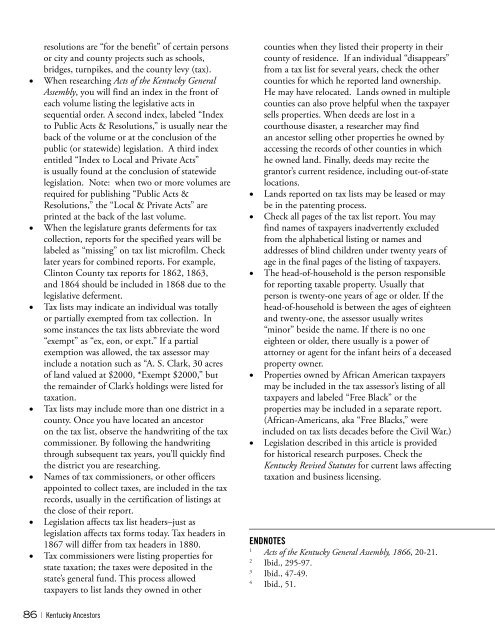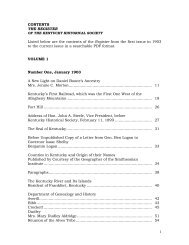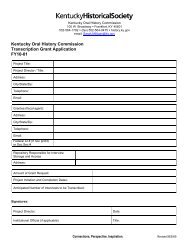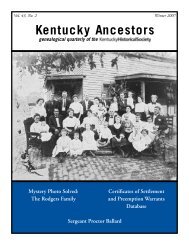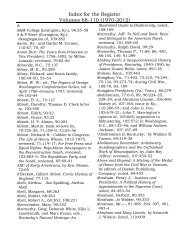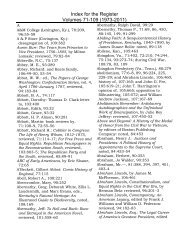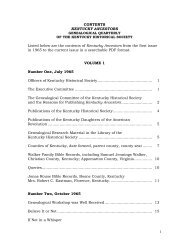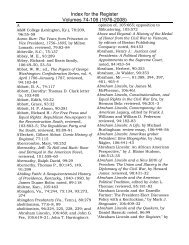Kentucky Ancestors, Volume 46, Number 2 - Kentucky Historical ...
Kentucky Ancestors, Volume 46, Number 2 - Kentucky Historical ...
Kentucky Ancestors, Volume 46, Number 2 - Kentucky Historical ...
You also want an ePaper? Increase the reach of your titles
YUMPU automatically turns print PDFs into web optimized ePapers that Google loves.
esolutions are “for the benefit” of certain persons<br />
or city and county projects such as schools,<br />
bridges, turnpikes, and the county levy (tax).<br />
• When researching Acts of the <strong>Kentucky</strong> General<br />
Assembly, you will find an index in the front of<br />
each volume listing the legislative acts in<br />
sequential order. A second index, labeled “Index<br />
to Public Acts & Resolutions,” is usually near the<br />
back of the volume or at the conclusion of the<br />
public (or statewide) legislation. A third index<br />
entitled “Index to Local and Private Acts”<br />
is usually found at the conclusion of statewide<br />
legislation. Note: when two or more volumes are<br />
required for publishing “Public Acts &<br />
Resolutions,” the “Local & Private Acts” are<br />
printed at the back of the last volume.<br />
• When the legislature grants deferments for tax<br />
collection, reports for the specified years will be<br />
labeled as “missing” on tax list microfilm. Check<br />
later years for combined reports. For example,<br />
Clinton County tax reports for 1862, 1863,<br />
and 1864 should be included in 1868 due to the<br />
legislative deferment.<br />
• Tax lists may indicate an individual was totally<br />
or partially exempted from tax collection. In<br />
some instances the tax lists abbreviate the word<br />
“exempt” as “ex, eon, or expt.” If a partial<br />
exemption was allowed, the tax assessor may<br />
include a notation such as “A. S. Clark, 30 acres<br />
of land valued at $2000, *Exempt $2000,” but<br />
the remainder of Clark’s holdings were listed for<br />
taxation.<br />
• Tax lists may include more than one district in a<br />
county. Once you have located an ancestor<br />
on the tax list, observe the handwriting of the tax<br />
commissioner. By following the handwriting<br />
through subsequent tax years, you’ll quickly find<br />
the district you are researching.<br />
• Names of tax commissioners, or other officers<br />
appointed to collect taxes, are included in the tax<br />
records, usually in the certification of listings at<br />
the close of their report.<br />
• Legislation affects tax list headers–just as<br />
legislation affects tax forms today. Tax headers in<br />
1867 will differ from tax headers in 1880.<br />
• Tax commissioners were listing properties for<br />
state taxation; the taxes were deposited in the<br />
state’s general fund. This process allowed<br />
taxpayers to list lands they owned in other<br />
86 | <strong>Kentucky</strong> <strong>Ancestors</strong><br />
counties when they listed their property in their<br />
county of residence. If an individual “disappears”<br />
from a tax list for several years, check the other<br />
counties for which he reported land ownership.<br />
He may have relocated. Lands owned in multiple<br />
counties can also prove helpful when the taxpayer<br />
sells properties. When deeds are lost in a<br />
courthouse disaster, a researcher may find<br />
an ancestor selling other properties he owned by<br />
accessing the records of other counties in which<br />
he owned land. Finally, deeds may recite the<br />
grantor’s current residence, including out-of-state<br />
locations.<br />
• Lands reported on tax lists may be leased or may<br />
be in the patenting process.<br />
• Check all pages of the tax list report. You may<br />
find names of taxpayers inadvertently excluded<br />
from the alphabetical listing or names and<br />
addresses of blind children under twenty years of<br />
age in the final pages of the listing of taxpayers.<br />
• The head-of-household is the person responsible<br />
for reporting taxable property. Usually that<br />
person is twenty-one years of age or older. If the<br />
head-of-household is between the ages of eighteen<br />
and twenty-one, the assessor usually writes<br />
“minor” beside the name. If there is no one<br />
eighteen or older, there usually is a power of<br />
attorney or agent for the infant heirs of a deceased<br />
property owner.<br />
• Properties owned by African American taxpayers<br />
may be included in the tax assessor’s listing of all<br />
taxpayers and labeled “Free Black” or the<br />
properties may be included in a separate report.<br />
(African-Americans, aka “Free Blacks,” were<br />
included on tax lists decades before the Civil War.)<br />
• Legislation described in this article is provided<br />
for historical research purposes. Check the<br />
<strong>Kentucky</strong> Revised Statutes for current laws affecting<br />
taxation and business licensing.<br />
ENDNOTES<br />
1 Acts of the <strong>Kentucky</strong> General Assembly, 1866, 20-21.<br />
2 Ibid., 295-97.<br />
3 Ibid., 47-49.<br />
4 Ibid., 51.


